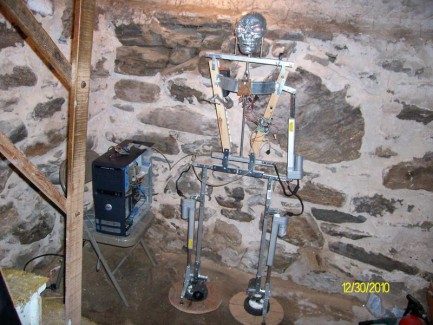Humanoid Robot D-100
This is D-100, my first full-sized humanoid robot. Obviously he has a lot of design issues, but I had three project goals:
1# Make it walk
2# Make it smart
3# Make it look cool.
He walks, albeit slowly. He tilts his weight over one foot by using linear actuators at his ankles as well as shifting his whole torso to one side using another actuator via a parallel link design. Once all the weight is on one foot, the windshield wiper motor (YES, I know the bearings are weak, which is why I built that whole reinforcement assemble on the foot =] ) powers up and spins the whole robot on that foot for about 1/4 turn. He sets his weight back down over the other foot and spins again. Repeat this a bunch of times and you get a simple yet stable walking motion. I'll try to get a video up soon, assuming I buy more mini-DVRs for my camera.
So, he walks, 1#'s goal was met.
For the brains I used an OOPic-R microcontroller connected via RS32 to a BX-24p, which is a fantastic microcontroller I'll mention...easy to program and it exucutes instructions BLAZING fast. So they can talk back and forth. The main reason I used a master-slave system was simple that I had never tried it before and I thought it would be fun. I made the OOpic the master only because I love object oriented programming and I'm best with programming the oopic so....yeah. The BX-24 is the slave because it follows orders fast. The OOpic is connected via serial to a PC running Windows XP, which I use to program it as well as experiment with a simple Neural Net program I'm working on. Right now I;m working on a Genetic Algrorithm, I'm hoping to make the robot teach itself to walk.
Aside from the brains, D-100 also has a couple of sensors (I listed them all in the profile) just for experimental use. I'm working on implemented a gyro to make my life easier, better than the tilt switches on the feet.
So he's...pretty smart. (In my opinion)
And lastly, he needed to look cool. Just look at him, not too too bad eh? =]
He has problems, I used aluminum in a few bad spots, which I'm correcting, I also wanna re-do the microcontroller master-slave thing and make it more streamlined, as right now it is kinda chunky and inefficient.
It was fun though, I hope you like it!!!
Walks on two legs, follows sound, light up eyes, shifts weight more like a human
- Actuators / output devices: 3x Linear Actuators (120 lb force), 2 red LEDs, 2 Windshield Wiper Motors
- Control method: fully autonomous
- CPU: 1 OOPIC-R, 1 BasicX BX-24p on Savage Innovations Carrier Board, Dell PC Dual-Core 2.5 Ghz with 2GB RAM
- Operating system: Windows XP SP3
- Power source: 4x 18 Volt cordless drill batteries
- Programming language: Basic, C, Java (OOpic runs all three so it depends on what I'm trying to do)
- Sensors / input devices: IS471 IR Detector, 1 x Sharp GP2D12, 1 microphone with custom circuit, 4 encoders, 8 microswitches (feet)
- Target environment: Indoor mainly, it can walk outside on flat surfaces


